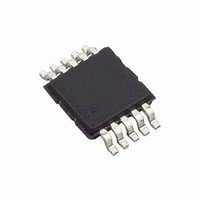HMC1052 Honeywell Microelectronics & Precision Sensors, HMC1052 Datasheet - Page 6

HMC1052
Manufacturer Part Number
HMC1052
Description
SENSOR MAGN 2 AXIS 10-MSOP
Manufacturer
Honeywell Microelectronics & Precision Sensors
Type
Linearr
Datasheet
1.HMC1051Z-RC.pdf
(11 pages)
Specifications of HMC1052
Output Type
Differential Voltage
Sensing Range
±6g
Voltage - Supply
1.8 V ~ 20 V
Features
Compass - Two Axis
Operating Temperature
-40°C ~ 125°C
Package / Case
10-MSOP
Supply Voltage
3V
Sensitivity Range
1.2mV/V/G
Sensor Terminals
Through Hole
Leaded Process Compatible
No
Supply Current
10mA
Magnetic Field Max
6G
Axis Configuration
Two
Lead Free Status / RoHS Status
Lead free / RoHS Compliant
Current - Supply
-
Current - Output (max)
-
Lead Free Status / RoHS Status
Lead free / RoHS Compliant, Lead free / RoHS Compliant
Other names
342-1029-2
Available stocks
Company
Part Number
Manufacturer
Quantity
Price
Part Number:
HMC1052
Manufacturer:
HMC
Quantity:
20 000
Company:
Part Number:
HMC1052L
Manufacturer:
Honeywell
Quantity:
2 401
Part Number:
HMC1052L
Manufacturer:
HMC
Quantity:
20 000
Company:
Part Number:
HMC1052L-TR
Manufacturer:
HONEYWELL
Quantity:
950
Part Number:
HMC1052L-TR
Manufacturer:
HONEYWELL
Quantity:
20 000
Part Number:
HMC1052M10
Manufacturer:
HITTITE
Quantity:
20 000
HMC1051/HMC1052/HMC1053
HMC105X parts may be reworked with soldering irons, but extreme care must be taken not to overheat the copper pads
(must not exceed maximum device reflow temperatures) from the part’s fiberglass substrate. Irons with a tip temperature
no greater than 315°C should be used. Excessive rework risks the copper pads pulling away into the molten solder.
DEVICE OPERATION
The Honeywell HMC105X family of magnetoresistive sensors are Wheatstone bridge devices to measure magnetic fields.
With power supply applied to a bridge, the sensor converts any incident magnetic field in the sensitive axis direction to a
differential voltage output. In addition to the bridge circuit, the sensor has two on-chip magnetically coupled straps; the
offset strap and the set/reset strap. These straps are Honeywell patented features for incident field adjustment and
magnetic domain alignment; and eliminate the need for external coils positioned around the sensors.
The magnetoresistive sensors are made of a nickel-iron (Permalloy) thin-film deposited on a silicon wafer and patterned
as a resistive strip element. In the presence of a magnetic field, a change in the bridge resistive elements causes a
corresponding change in voltage across the bridge outputs.
These resistive elements are aligned together to have a common sensitive axis (indicated by arrows on the pinouts) that
will provide positive voltage change with magnetic fields increasing in the sensitive direction. Because the output only is in
proportion to the one-dimensional axis (the principle of anisotropy) and its magnitude, additional sensor bridges placed at
orthogonal directions permit accurate measurement of arbitrary field direction. The combination of sensor bridges in two
and three orthogonal axis permit applications such as compassing and magnetometry.
The offset strap allows for several modes of operation when a direct current is driven through it. These modes are: 1)
Subtraction (bucking) of an unwanted external magnetic field, 2) null-ing of the bridge offset voltage, 3) Closed loop field
cancellation, and 4) Auto-calibration of bridge gain.
The set/reset strap can be pulsed with high currents for the following benefits: 1) Enable the sensor to perform high
sensitivity measurements, 2) Flip the polarity of the bridge output voltage, and 3) Periodically used to improve linearity,
lower cross-axis effects, and temperature effects.
NOISE CHARACTERISTICS
The noise density for the HMR105X series is around 50nV/sqrt Hz at the 1 Hz corner, and quickly drops below 10nV/sqrt
Hz at 5Hz and begins to fit the Johnson Noise value at just below 5nV/sqrt Hz beyond 50Hz. The 10Hz noise voltage
averages around 1.4 micro-volts with a 0.8 micro-volts standard deviation.
CROSS-AXIS EFFECT
Cross-Axis effect for the HMR105X series is typically specified at ±3% of full scale to 1 gauss. See application note
AN215 regarding this effect and methods for nulling.
OFFSET STRAP
The offset strap is a spiral of metalization that couples in the sensor element’s sensitive axis. In two-axis designs, the
strap is common to both bridges and must be multiplexed if each bridge requires a different strap current. In three-axis
designs, the A and B bridges are together with the C bridge sharing a common node for series driving all three bridges’
offset straps. Each offset strap measures nominally 15 ohms, and requires 10mA for each gauss of induced field. The
straps will easily handle currents to buck or boost fields through the ±6 gauss linear measurement range, but designers
should note the extreme thermal heating on the die when doing so.
With most applications, the offset strap is not utilized and can be ignored. Designers can leave one or both strap
connections (Off- and Off+) open circuited, or ground one connection node. Do not tie both strap connections together to
avoid shorted turn magnetic circuits.
SET/RESET STRAP
The set/reset strap is another spiral of metallization that couples to the sensor elements easy axis (perpendicular to the
sensitive axis on the sensor die). Like the offset strap, the set/reset strap runs through a pair of bridge elements to keep
the overall die size compact. Each set/reset strap has a nominal resistance of 3 to 6 ohms with a minimum required peak
6
www.honeywell.com






















